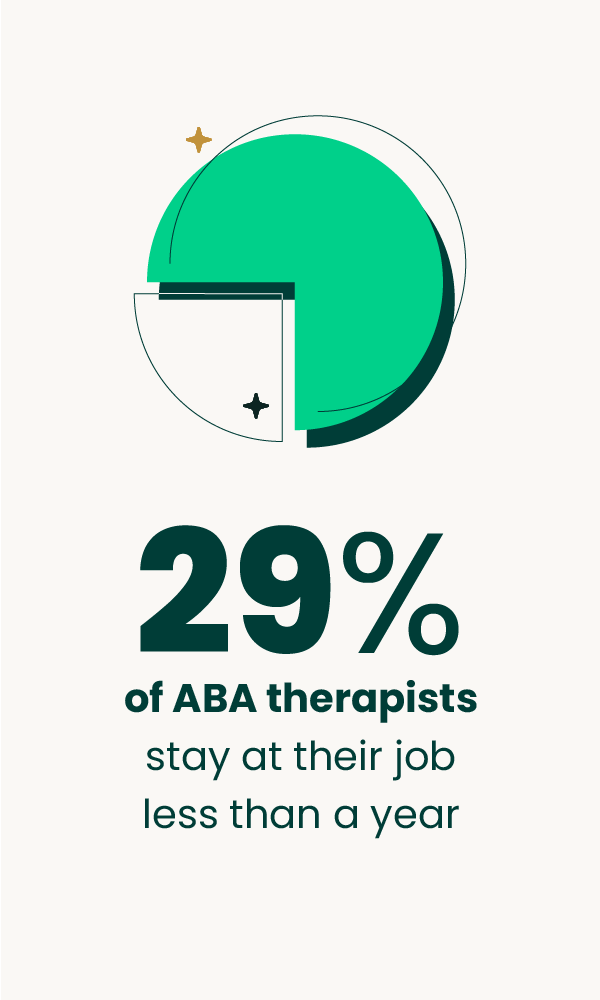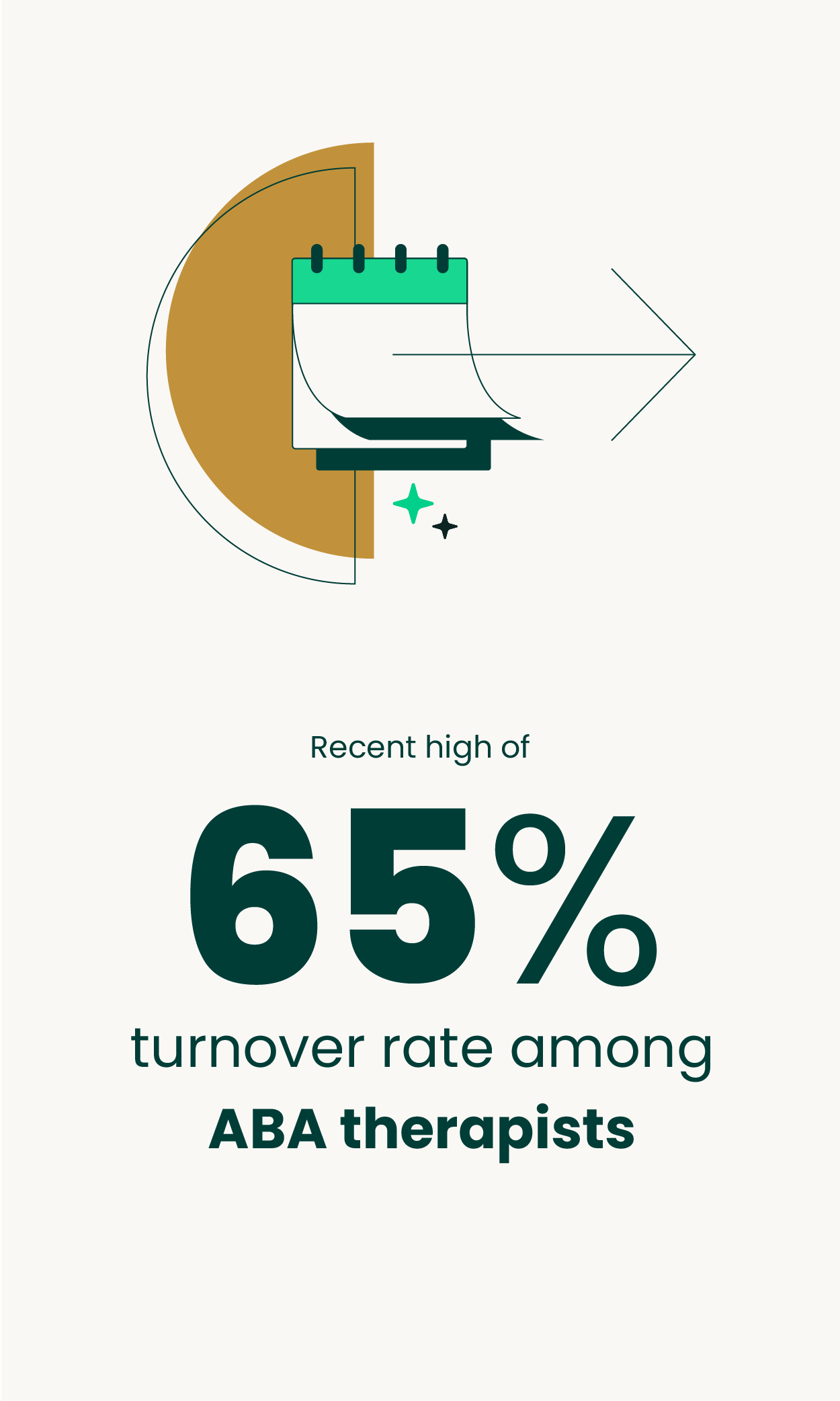
An Applied Behavior Analysis (ABA) therapist performs highly specialized therapy with children on the autism spectrum, individuals with developmental disabilities and similar conditions.
It is essential work that can make an enormous difference in a patient’s life, but staffing and maintaining trained ABA therapists continues to be an ongoing challenge.

According to the 2022 ABA Compensation & Turnover Report from the BHCOE Accreditation, the turnover rate for ABA therapists averaged 65%. Which means for every three new employees hired, two more resign in the same period. Zippa also records that the average ABA therapist only remains at their job for 1 – 2 years. This puts enormous strain on the organization as they need to commit continued resources hiring, onboarding, and training new employees only for a majority of them to move on.
Beyond the logistical expenses for the business, the patients suffer as well. ABA therapy, particularly with children, benefits from a longstanding relationship. Further, caregivers are put at ease by a familiar face working with their child from week to week.
Turnover is clearly a problem, but it’s a problem you can solve. Read on to learn key strategies to reduce turnover, retain top talent, and decrease costs associated with hiring and onboarding.

”Working with populations with behavioral disorders is emotionally taxing, and when combined with a difficult schedule and modest compensation, ABA therapists are vulnerable to apathy and fatigue.
Understanding the Root Cause of Turnover
To solve a problem, you must first understand it. ABA therapists leave their positions for many of the same reasons as other professionals including higher salaries, better and more reliable hours, and improved benefits. However, medical professionals, including ABA therapists, are much more prone to burnout than other fields. Working with populations with behavioral disorders is emotionally taxing, and when combined with a difficult schedule and modest compensation, ABA therapists are vulnerable to apathy and fatigue.

Know the Signs of Burnout
If members of your team are exhibiting some of the following characteristics, they may be struggling in their position. To curb burnout, these therapists need some time off to recharge.
Your team member is burnt out if they…
- Are making new and additional errors in their work activities, particularly if the errors are careless omissions or mistakes
- Are absent from work without notice and without a history of such behavior
- Complain about work volumes
- Avoid work-related social engagements
- Display a lack of enthusiasm for existing responsibilities or new initiatives
- Are apathetic or cynical toward company policies
Seven Ways to Reduce ABA Therapist Turnover
The simplest way to motivate a workforce is through higher compensation, but that is not an option for many organizations.
Margins are tight and expenses are high. Short of a higher salary, there are still ways an organization can improve the working experience for their team and compete in the hiring market with a more attractive offer.
”High turnover creates a competitive labor market, but you can secure top talent with a superior hiring process
1
Improve Hiring and Onboarding
High turnover creates a competitive labor market, but you can secure top talent with a superior hiring process. By establishing a smooth, streamlined hiring process that swiftly screens candidates and moves them through interviews, your organization can submit offers to the best candidates more quickly than your competitors. More, by seamlessly moving from hiring to an onboarding process, your new ABA therapist can host sessions as soon as possible.
To establish a modern hiring process, organizations deploy an applicant tracking system (ATS), such as Apploi Hire, and an onboarding solution, such as Apploi Onboarding. These solutions allow you to maintain more frequent contact with your applications through automated, unlimited messaging while automatically scheduling interviews post-screening.
Apploi Onboarding digitizes the legal paperwork associated with a new hire and ensures compliance at each step. Apploi Onboarding also verifies up to ten types of licensing credentials and sends reminders to both employees and employers to ensure licenses are renewed on time.
Get your free demo
Apploi is the all-in-one platform to hire, onboard, & schedule top healthcare talent

”This empowers your team to work a schedule that fits their life while protecting the organization against excess costs.
2
Decrease Overtime Spend and Improve Satisfaction with Flexible Scheduling
By reducing hiring and onboarding costs, the organization can reinvest the savings into additional efficiency-creating solutions.
Your facility can reduce or eliminate overtime expenditure by deploying an advanced scheduling software, such as with Apploi Schedule. Apploi Schedule digitizes and automates the scheduling process while preventing the team from accidentally going into overtime with optional alert. The Selective Shift Offering feature gives the team enhanced flexibility by picking up or trading away their shifts up to the last minute, however you’re able to adjust Apploi Schedule to only display those shifts to employees not at risk of exceeding 40 hours.
3
Set Clear Expectations When Hiring
During the interview process both parties are trying to determine if there is a match between them. Is this where the applicant really wants to work? Is the applicant the best fit for the position?
To decrease your employee turnover rate, be as transparent as possible during this process. Explain the workload, scheduling challenges, compensation range, and any other relevant figures. You want the applicant to have as clear a picture of their future responsibilities as possible.
This ensures there are no surprises after the job offer is signed. The new therapist on the team understands front to back what is required of them and what they will need in order to be successful.
4
Set Employee Goals
In ABA therapy, the work is never truly done. Therapists render a service for a docket of clients, and though the details of one session will differ from the next, there is always another client. There is always another session. That environment can leave an employee feeling unproductive over time and contribute to burnout. A patient may improve, but the day to day for the therapist remains the same. Furthermore, the work leaves little for management to point to as an achievement. It can be difficult to recognize the exceptional efforts of the team.
By establishing monthly, quarterly, and yearly goals, you can better inspire your team to improve. Pair these goals with regular meetings to discuss progress, and the monotony of service-oriented work can be flipped on its head. Now, each session builds towards a personal challenge in a gamified structure that rewards their efforts.
5
Offer Competitive Benefits
Your competitors are likely to face the same salary constraints as you, which means additional employment benefits are an effective way to improve the quality of your job offer and retain staff. Redirect cost savings in the area of hiring and scheduling to higher quality health insurance plans, retirement plans, or wellness programs. Something as simple as a meditation app or gym membership can help retain your team.
”Burnout festers in therapists who feel like their career has become a dead-end job.
6
Offer Training Programs and Continuing Education
Burnout festers in therapists who feel like their career has become a dead-end job. If the hours are hard, the workload is high, and there’s no tangible improvement over time, therapists will quickly begin to ask, “what’s the point?”
To combat this, take an interest in the career goals and growth potential of each therapist. Investing in continuing education programs and training, much like setting employee goals, gives the therapist something to work towards. It offers the promise of a broadened skillset, greater marketability, and new challenges.
7
Build Peer Support Programs
To increase collaboration and connection among the team, establish a peer support program. These programs allow therapists to voice their challenges, receive input from their peers, and seek solutions. It helps the team feel cohesive and invested in both their patient’s and their colleague’s success.
These programs do not need to be complex. A simple SMS text chat group can relieve a lot of tension for virtually no cost. If choosing to invest in software solutions to facilitate these groups, seek HIPAA compliant software that will allow the team to maintain confidentiality of their patients, share files, and organize their discussions around key themes. A single chat feed can become confusing depending on the size of the support group — consider building channels by topic (i.e. work questions vs. meme sharing).
Summary
The high turnover rate among ABA therapists is a difficult problem to solve, but every effort contributes to the larger goal. Along the way, your company can also enjoy reduced hiring, onboarding, and scheduling costs through sophisticated software solutions that simplify manual processes. Best of all, patients benefit from a more engaged, more committed team.
Looking for ways to improve your hiring process? Check out this blog post with best practices on hiring healthcare workers.
Read How to Hire Occupational Therapists for Long-Term Care.




